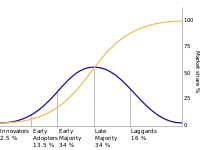
Photo from wikipedia
The notion of team science has recently gained popularity in European and American health sciences reviewing the increasing evidence that scientific collaboration produces higher-impact research and that complex scientific problems… Click to show full abstract
The notion of team science has recently gained popularity in European and American health sciences reviewing the increasing evidence that scientific collaboration produces higher-impact research and that complex scientific problems are better investigated by interdisciplinary teams. While publication surveys indicate that adoption research is expanding, it has not been formally evaluated for collaborative and cross-disciplinary activity. This article aims to elucidate the structure, composition and dynamics of scientific relationships within adoption studies that may inform research and practice strategies, competencies and cohesion within the field. Using social network analysis, we extracted data on 2767 peer-reviewed adoption-related articles from the 1930s to 2014 and evaluated the resulting co-authorship and co-citation networks. We found that adoption research has grown substantially over the last 25 years and is conducted in varied disciplines, with increasing collaboration across geography and disciplinary areas. As a result, the co-authorship and co-citation networks are approaching numeric thresholds and structural configurations distinctive of well-established and more institutionalised fields of study. These findings reveal the maturation of adoption studies as a team science and argue for the development of institutional mechanisms that support such evolution. Implications for professional and research planning are discussed.
Journal Title: Adoption & Fostering
Year Published: 2017
Link to full text (if available)
Share on Social Media: Sign Up to like & get
recommendations!